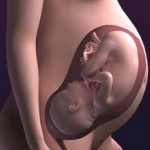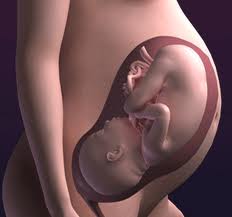A miscarriage is the spontaneous loss of a fetus before the 20th week of pregnancy. (Pregnancy losses after the 20th week are called preterm deliveries.)
A miscarriage may also be called a “spontaneous abortion.” This refers to naturally occurring events, not medical abortions or surgical abortions.
 Other terms for the early loss of pregnancy include:
Other terms for the early loss of pregnancy include:
- Complete abortion: All of the products of conception exit the body
- Incomplete abortion: Only some of the products of conception exit the body
- Inevitable abortion: The symptoms cannot be stopped, and a miscarriage will happen
- Infected (septic) abortion: The lining of the womb, or uterus, and any remaining products of conception become infected
- Missed abortion: The pregnancy is lost and the products of conception do not exit the body
Causes, incidence, and risk factors
Most miscarriages are caused by chromosome problems that make it impossible for the baby to develop. Usually, these problems are unrelated to the mother or father’s genes.
Other possible causes for miscarriage include:
- Drug and alcohol abuse
- Exposure to environmental toxins
- Hormone problems
- Infection
- Obesity
- Physical problems with the mother’s reproductive organs
- Problem with the body’s immune response
- Serious body-wide (systemic) diseases in the mother (such as uncontrolled diabetes)
- Smoking
It is estimated that up to half of all fertilized eggs die and are lost (aborted) spontaneously, usually before the woman knows she is pregnant. Among those women who know they are pregnant, the miscarriage rate is about 15-20%. Most miscarriages occur during the first 7 weeks of pregnancy. The rate of miscarriage drops after the baby’s heart beat is detected.
The risk for miscarriage is higher in women:
- Older age, with increases beginning by 30, becoming greater between 35 and 40, and highest after 40
- Who have had previous miscarriages
Symptoms
- Low back pain or abdominal pain that is dull, sharp, or cramping
- Tissue or clot-like material that passes from the vagina
- Vaginal bleeding, with or without abdominal cramps
Signs and tests
During a pelvic exam, your health care provider may see the cervix has opened (dilated) or thinned out (effacement).
Abdominal or vaginal ultrasound may be done to check the baby’s development, heart beat, and amount of bleeding.
The following blood tests may be performed:
- Blood type (if you have an Rh-negative blood type, you would require a treatment with Rh-immune globulin. incompatibility)
- Complete blood count (CBC) to determine how much blood has been lost
- HCG (qualitative) to confirm pregnancy
- HCG (quantitative) done every several days or weeks
- WBC and differential to rule out infection
Treatment
 When a miscarriage occurs, the tissue passed from the vagina should be examined to determine if it was a normal placenta or a hydatidiform mole. It is also important to determine whether any pregnancy tissue remains in the uterus.
When a miscarriage occurs, the tissue passed from the vagina should be examined to determine if it was a normal placenta or a hydatidiform mole. It is also important to determine whether any pregnancy tissue remains in the uterus.
If the pregnancy tissue does not naturally exit the body, the woman may be closely watched for up to 2 weeks. Surgery (D and C) or medication (such as misoprostol) may be needed to remove the remaining contents from the womb.
After treatment, the woman usually resumes her normal menstrual cycle within 4 – 6 weeks. Any further vaginal bleeding should be carefully monitored. It is often possible to become pregnant immediately. However, it is recommended that women wait one normal menstrual cycle before trying to become pregnant again.
Complications
An infected abortion may occur if any tissue from the placenta or fetus remains in the uterus after the miscarriage. Symptoms of an infection include fever, vaginal bleeding that does not stop, cramping, and a foul-smelling vaginal discharge. Infections can be serious and require immediate medical attention.
Complications of a complete miscarriage are rare. However, many mothers and their partners feel very sad. Seemingly helpful advice like “you can try again,†or “it was for the best†can make it harder for mothers and fathers to recover because their sadness has been denied.
Women who lose a baby after 20 weeks of pregnancy receive different medical care. This is called premature delivery or fetal demise and requires immediate medical attention.
Calling your health care provider
 Call your health care provider if vaginal bleeding with or without cramping occurs during pregnancy.
Call your health care provider if vaginal bleeding with or without cramping occurs during pregnancy.
Call your health care provider if you are pregnant and notice tissue or clot-like material passed vaginally (any such material should be collected and brought in for examination).
Prevention
Early, comprehensive prenatal care is the best prevention available for all complications of pregnancy.
Many miscarriages that are caused by body-wide (systemic) diseases can be prevented by detecting and treating the disease before pregnancy occurs.
Miscarriages are less likely if you receive early, comprehensive prenatal care and avoid environmental hazards (such as x-rays, drugs and alcohol, high levels of caffeine, and infectious diseases).
When a mother’s body is having difficulty sustaining a pregnancy, signs (such as slight vaginal bleeding) may occur. This means there is a possibility of miscarriage, but it does not mean one will definitely occur. A pregnant woman who develops any signs or symptoms of threatened miscarriage should contact her prenatal provider immediately.

